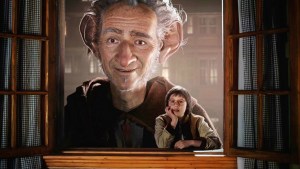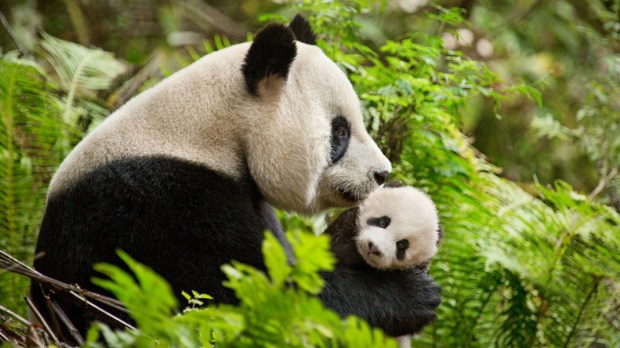Disney is famous for their make-believe worlds — their fairy tales and superheroes, their Haunted Mansions and Space Mountains. But every year or so, an offshoot of the Mouse House brings to the screen something real.
Disneynature released its latest nature documentary, Born in China, today (April 21), just a day before Earth Day. The studio describes the film as its “most ambitious project to date,” and that’s saying something. The film follows three “families” during its 76-minute run-time: those of giant pandas, golden monkeys, and incredibly elusive snow leopards. It’s beautiful and funny and — a word of warning to parents eager to take kids to the flick — sometimes tragic. Death is just as much a part of nature as life is, and the film acknowledges its reality.

Read more:
6 Animated family films on Netflix this April
A confession: I love nature flicks. It’s a love I’ve had ever since before I could tie my shoes. Every Sunday when I was a wee child, I’d shoo my dad away from his football games so I could watch Mutual of Omaha’s Wild Kingdom. I think most children love the natural world and the incredible creatures that populate it — the powerful lions and tigers, the graceful gazelles, the silly giraffes. There’s a reason why Noah’s Ark is one of the Bible’s most beloved stories.
Few of us see that sort of nature, of course. And as our lives become ever more urbanized and separated from the natural world around us, nature documentaries can feel, well, a little like fantasy. For some children, the world we see in Born in China feels less real, less familiar, than the made-up worlds of Frozen or Star Wars. And indeed, that world is disappearing. Which is why I think it’s important to teach our kids as much about it as we can — so they can help protect it.
Thankfully, Born in China is hardly unique. There are loads of great, beautiful and inspiring nature documentaries out there that can teach kids (and their parents, too) about the beautiful, powerful, natural world around us. Here are five such movies worth your time. (All films are rated G and available on iTunes, Amazon and/or YouTube for around $2.99.)
March of the Penguins (2005)
This French documentary was an out-of-the-blue hit when it was released in 2005, earning $127.4 million. I just hope that the two cinematographers who spent a year in Antarctica filming said penguins got a nice, healthy cut. The film, which traces the annual journey of thousands of emperor penguins from the ocean to their traditional breeding grounds, is a beautiful, poignant look at some truly fowl families. Penguin dads cup new eggs on their feet to keep them from touching the freezing ground. They don’t eat at all during this time: Penguin moms trek back to the ocean (sometimes 50 miles away) to gorge themselves on seafood, which they bring back to re-feed to their newly hatched chicks. It’s a poignant and painful journey (not every penguin, be they chick or adult, survives). And the penguins here — creatures I long considered nature’s comic relief — turn into strangely majestic stand-ins for our own parenting journeys. And here’s another twist: Many a Christian has watched the film and seen echoes of God’s own love for us and the stark, beautiful mystery of His creation.
Chimpanzee (2012)
From Bambi to Nemo, it sometimes seems like every Disney animal protagonist is required to lose a parent along the way. Apparently, that even extends to some of its nature docs. Chimpanzee focuses on a young chimp, Oscar, whose mother is apparently killed early on by a leopard. Oscar, orphaned and alone, tries to find a caregiver among the other chimps in his mother’s tribe, but to no avail: He’s roundly rejected until finally, in desperation, he approaches the tribe’s grouchy, tough-as-nails leader, Freddy. Freddy, remarkably, takes the young Oscar under his wing and the two become inseparable. The story not only takes us deep within a beautiful, green forest and introduces us to the creatures therein, it reminds us that help, and friendship, can often be found in unexpected places. And as a father myself, I kinda teared up at the end of this one.
Winged Migration (2001)
Have you ever wanted to fly like a bird? This French documentary gives you a taste of what it must feel like. Much of the footage we see has the camera (held aloft by ultralight aircraft, paragliders and hot air balloons) flying alongside migrating birds as though it were a bird itself, soaring over spectacular landscapes and braving frightening storms. To get this incredible footage, filmmakers raised many of these birds from the egg and essentially “trained” them to accept the filmmakers and their equipment: As such, its producers don’t call it a documentary in the strictest sense. But doc or no, the images we’re given here are truly breathtaking.
African Cats (2011)
Another Disneynature doc, African Cats looks primarily at two large felines: Mara, a lion cub; and Sita, a cheetah who’s raising five young cubs of her own. The doc showcases the subtle, sometimes brutal dynamics of the African Savannah. Sita’s cubs are threatened by lions and hyenas. Mara has her own trials to overcome — from the premature death of her mother (oh, that Disney!) to the hostile takeover of her pride by another. (When the two prides merge, the lives of the cubs sired by the previous leader are immediately forfeit, forcing Mara out on her own far earlier than normal.) Given all the mammalian strife we see here, and the fact that the main players are, well, carnivores themselves, African Cats may be one of the more difficult documentaries on this list: But the action never turns graphic, the cinematography is predictably beautiful, and it showcases some pretty wonderful moms and kids — er, cubs — helping each other survive and thrive in a difficult world. Kind of like us, right?
Arctic Tale (2007)
The National Geographic Society created Arctic Tale as a sequel of sorts to the staggering successful March of the Penguins. Alas, it wasn’t nearly as successful: While March earned more nearly $130 million, Tale took less than $2 million. It’s a harder film to watch, too, given that much of it revolves around climate change and the animals most threatened by it. But it’s still a pretty wonderful movie, focusing on a young polar bear named Nanu and a female walrus named Seela. (Both characters were actually made in the editing room from a composite of a number of different subjects.) If you’re not a big believer in climate change, this is one to skip. But for everyone else, this Tale is a cool one indeed.
Don’t want to download one of these excellent movies? Never fear. Check out the BBC’s breathtaking Planet Earth series on Netflix — an 11-episode odyssey through Earth’s incredibly diverse habitats. The series reportedly took five years to make, and it shows. (A word of caution, though. This show can be more violent and challenging than the G-rated films listed above.)
Or even better, take your kids for a walk through real-life nature. You don’t need to live next to a forest or beach to find God’s magnificent creation. Dandelions and pillbugs are just as beautiful, just as glorious, if you look closely enough.

